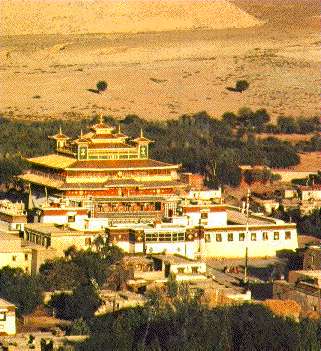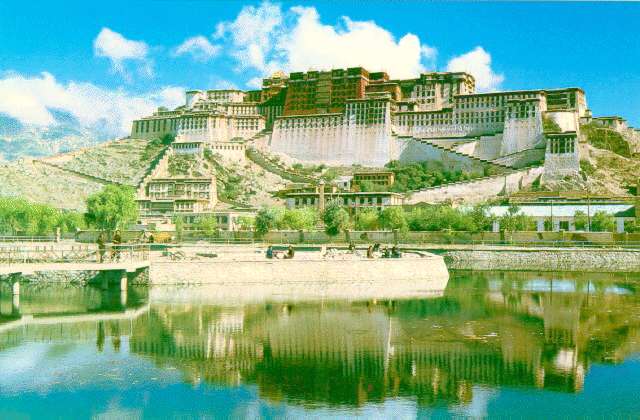The introduction of Buddhism into
Tibet would change the course of Central Asian history. Aside from
initiating the first contact between Tibet and China, Songtsen Gampo is
also known for introducing a writing system and, more importantly, Buddhism
in the latter half of the seventh century. The introduction of Buddhism
probably resulted from the influence of two of Songtsen’s wives, one being
the aforementioned Tang Chinese princess and the other being a Nepalese
princess (Waddell 784). At this time Buddhism was not widespread
in Tibet and was confined mainly to royalty and nobility. The Buddhism
in Tibet was of a distinct Indian background in Tantric and Mahayana Buddhism.
The way these combined with the native animist religion of Bon to form
the distinct Lamaist sect will be discussed at further length later.
The first Buddhist monastery, called Samye, was built in 779 and signaled
the beginning of Buddhism’s popular acceptance (Richardson 31). The
highly stratified Tibetan social structure, consisting of an upper class
of nobles and a lower class of commoners, would have to adjust to include
monks and eventually Lamas. The transition was eased partly by the
fact that the early Tibetan Buddhist monks came from the existing upper
class, but Lamaist Buddhism would soon spread to the masses.

The development of the unique Buddhist
sect of Lamaism was greatly influenced by the Buddhism of India.
Songtsen Gampo urged for the translation of Buddhist writings from India.
His grandson, Ti-song-Detsen, invited a Tantric Buddhist scholar to enhance
the position of Buddhism in Tibet, as the people were more accepting of
Tantric Buddhism due to its similarities with Bon, an animist religion
(Burman 4-5). Tantric Buddhism focuses on channeling and controlling
energies for the sake of overcoming the sufferings that arise when one
is unable to tame the mind. Mahayana Buddhism also greatly influenced
Lamaism and was the major sect in India at the time, with its focus on
enlightenment for all. Mahayana Buddhists strive for the rank of
“Buddhahood, the nonabiding nirvana, the supreme liberation, for the sake
of others” (H. H. the Dalai Lama 29-30). The Tibetans somehow managed
to combine these three ideologies to form Lamaism.
This new religion would eventually
serve to unite the people of an area that to this point had lacked a major
unifying factor. Just as this unifying factor was starting to gain
momentum, though, Lang Darma, the last in Songtsen Gampo’s line, persecuted
Buddhism with such intensity that it was almost driven out of Tibet completely.
After his death in 842 the kingdom broke up into several small kingdoms
and Buddhism went into remission for a while. The Tang dynasty declined
almost concurrently with the Tibetan Empire, but outlasted its western
counterpart just long enough to regain the territories that had been taken
by Tibet. Tibet would never again reach these territorial borders
and turned inward in its isolated mountain plateau. China and Tibet
would have no major contact for over three hundred years after the fall
of the Tang Dynasty in 905 and Buddhism would lie stagnant for about two
hundred years until a revival started in 1042 (Richardson 32-33).
After this revival Buddhism regained its momentum quickly over the next
two hundred years as Lamaism turned into a major force in Central Asia.

Tibet was finally dragged out of its
isolation by the emergence of the Mongol empire in the 13th century.
Genghis Khan had risen to power and expanded dangerously close to Tibet
in 1207. The Tibetans avoided Mongolian conquest by offering submission,
but this lasted only until 1239 when Godan, a regional Mongol governor,
pushed almost to Lhasa and then in 1247 named Sakya Pandita, a Tibetan
Lama, Viceregent in Tibet. Then in 1253 a nephew of Sakya Pandita
visited the court of Kublai Khan, who had become the Mongolian leader in
1251. Khan was so impressed by him that he appointed him his chaplain
and gave him sovereignty over all of Tibet (Richardson 33-34).
Tibet had instantaneously gone from
complete isolation to accepting a Mongol overlord, with explicit religious
ties between the two. The Mongols went on to conquer all of China
in 1279 and found the Yuan dynasty, reestablishing a link between Tibet
and China. The successors of Khan were not well liked in Tibet and
a national prince named Chang-chub Gyaltsen, with the help of secular and
religious leaders in Tibet, assumed control of the nation by 1358.
The Yuan leaders seemed to have little interest in these developments and
so once again Tibet existed as a sovereign nation (Feigon 63). Limited
contact with China would continue throughout the Ming dynasty despite Ming
efforts to gain influence in Tibet.
During the time of Mongol control and
national reemergence in Tibet Buddhism became an integral part of Tibetan
affairs. From the reemergence of Buddhism in the 11th century through
the Yuan and Ming dynasties, religious influence in state affairs grew
due to the spread of Lamaism and the growing monastic life. Starting
in the 11th century, Buddhism reemerged as the dominant religion in Tibet
and by the time of Genghis Khan's presence in the region in 1207, many
religious leaders held secular positions in the government. The Buddhist
monasteries, like those of China, were forces to be reckoned with, each
with its own army. The Mongols established the first religious head
of state in Sakya Pandita in 1247, but leaders of other sects were jealous
of the distinction and Chang-chub Gyalsten would rise to power (Richardson
39-40).
The Dalai Lamas did not come into existence
until the late 14th century when Tsong Khapa founded a new sect called
the Gelugpa, or Yellow Hat sect (Burman 8). Tsong Khapa aimed to
reform monasticism in Tibet in an attempt to end the divisions that existed
between the many sects in Tibet. His nephew, Gedun Truppa, carried
on for his uncle and founded a great Gelugpa monastery. He died in
1475 and within years it was found that he had been reincarnated into a
young monk named Gedun Gyatso, who was reincarnated into a child named
Sonam Gyatso upon his death. Sonam Gyatso grew into a man of incredible
talents and managed to convert a leading Mongolian prince in 1578.
The prince gave him the title of Dalai, which means ocean, to signify the
depth of his knowledge. Since he was the third incarnation of Gedun
Truppa, he later became known as the third Dalai Lama (Richardson 40-41).
Soon the new sect was followed by almost all of the Mongolian tribes, which
had important ramifications.
This sect would serve to unify the
Mongolian tribes, leading to the rise of the Dalai Lama as the leader of
Tibet. In the meantime, the sect gradually gained influence in Tibetan
secular life to rival the dominant sect of the time. In 1642 a Mongol
prince named Gusri Khan invaded Tibet and deposed the King and ruling sect.
He placed the fifth Dalai Lama as the religious head of Tibet. Gusri
Khan died in 1655 and his successors, like those of Kublai Khan, had little
interest in Tibet. This allowed the fifth Dalai Lama, a charismatic
and determined man, to assume secular power over Tibet (Richardson 41-42,
44, 45). Lamaism had risen from a small sect grown out of three unique
ideologies, to the dominating force in Tibetan religion and politics.
The fifth Dalai Lama died in 1682 and
conflict arose as a result. Sangye Gyatso, a regent under the Dalai
Lama, ruled after his death and was so hated that he was killed by Lhabzang
Khan, the son of Gusri. As a result the Dzungar Mongols invaded because
they were enemies of Lhabzang Khan. Lhabzang turned to K’ang Hsi,
the Qing emperor, for help. Lhabzang defeated the Dzungars with the
Qing help and continued to depose the sixth Dalai Lama, who was the son
of Sangye Gyatso and appeared to be an unsuitable Dalai Lama. Due
to his apparent unsuitability it seemed that the people would have no problem
with deposing the Dalai Lama and replacing him, but that was a faulty assumption.
The Tibetans were so devoted to the Dalai Lama that they overlooked his
shortcomings and when he was killed on a journey to China, the fury of
the Tibetan people was released. To make matters worse the Qing emperor
made Lhabzang Khan pay tribute in return for protection, marking the first
time Tibet would pay tribute to China (Richardson 46-48).
The people had found a child who they
believed to be the reincarnation of the Dalai Lama and with the help of
the Dzungars, hoped to replace the current Dalai Lama with this child.
The Dzungars defeated Lhabzang Khan, but K’ang Hsi had the good fortune
of having the child in his custody. Without the child, the Dzungars
were nothing but foreign intruders encroaching on Tibetan territory.
The people rose against the conquerors and hoped for help from China.
The emperor sent forces, drove the Dzungars out, and brought the child
Dalai Lama. Through this series of events, K’ang Hsi had cunningly
gained a significant influence in Lhasa, which would be crucial in maintaining
control over the dangerous Mongolians, seeing that they were Lamaists and
thus hailed allegiance to the Dalai Lama. The Qing first tried establishing
a military governor in Tibet, which was met with public disdain.
They then tried a civil leader with no military presence, but he lacked
any real power or protection. Finally they established two civil
leaders in Lhasa with an armed garrison to maintain order. These
men still had no real power but were there to report back to the Emperor
on the happenings of Tibet (Richardson 47-49, 51-52).
The Qing decided to systematically
reduce the power of the Dalai Lama in 1728 and eventually removed him from
Lhasa by inviting him to Peking. He was sidetracked on his way out
of Tibet, detained by Qing forces, and allowed to return to Lhasa only
on the condition that he did not take an active role in politics.
The reduction of the power of the Dalai Lama continued with the establishment
of the Panchen Lama by the Qing in 1728. This was used to challenge
the religious authority of the Dalai Lama by playing each Lama off the
other (Richardson 53). With the systematic reduction of the power
of the Dalai Lama, the Tibetan state was left mainly under the control
of the Chinese government, and this influence in Tibetan affairs by the
Chinese was a prelude of things to come in the 20th century.
|



